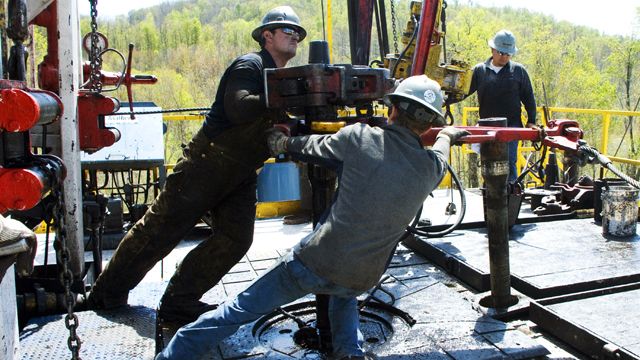
In Texas, Oklahoma, Ohio and other states, people who have rarely experienced earthquakes in the past are getting used to them as a fairly common phenomenon. This dramatic uptick in tremors is related to drilling for oil and natural gas, several reports find. And the growing popularity of hydraulic fracturing, or fracking, is in part to blame.
Between 1970 and 2000, there was an average of 20 earthquakes per year within the central and eastern United States. Between 2010 and 2013, there was an average of more than 100 earthquakes annually. A United States Geological Survey released last month summarized research on man-made earthquakes conducted by one of the agency’s geophysicists:
USGS scientists have found that at some locations the increase in seismicity coincides with the injection of wastewater in deep disposal wells. Much of this wastewater is a byproduct of oil and gas production and is routinely disposed of by injection into wells specifically designed for this purpose.
So, the actual hydraulic fracturing process itself is not to blame in these cases; instead, it’s the injection of wastewater into deep wells that accompanies it.
Hydraulic fracturing produces a higher volume of wastewater than traditional drilling — as the name implies, drillers use millions of gallons of high-pressure water, sand and chemicals to break apart rock and release gas trapped in pockets in the earth. The wastewater generated is often contaminated with salt or poisonous chemicals, and environmental regulations bar drilling companies from allowing it to mix with drinking water; oftentimes, the most economical way for these companies to dispose of it is to sequester it deep in the ground, below aquifers. Once there, it changes pressure underground and lubricates fault lines, with the potential effect of causing earthquakes.
In both Texas and Oklahoma, the number of earthquakes per year has increased ten-fold. And wells storing wastewater from fracking have also been linked to hundreds of earthquakes near Youngstown, Ohio.
Studies last year found that the largest quake ever recorded in Oklahoma — which was felt 800 miles away in Milwaukee, Wis., damaged 14 homes, injured two people and buckled a highway — could be linked to wastewater injection. Damage from the quake, which measured 5.6 on the Richter scale, “would be much worse if it were to happen in a more densely populated area,” the USGS wrote.

Chad Devereaux works at cleaning up the bricks that fell from three sides of his in-laws home in Sparks, Okla., Nov. 6, 2011, after two earthquakes hit the area in less than 24 hours. (AP Photo/Sue Ogrocki)
And as quakes increase in frequency, residents of Oklahoma and Texas are taking notice. More noticeable than the shaking, for many, is the noise these quakes make: a loud boom, like artillery fire.
In the Netherlands, where the Groningen gas field lies, quakes have also become more frequent, increasing from about 20 each year before 2011 to an average of one per week. Shell and Exxon Mobile, active in the gas field, set aside $130 million to strengthen buildings as the quakes increased in severity. But residents of the area worried that a 4-or-5 magnitude earthquake –the likelihood of which, experts warned, is increasing — would threaten the integrity of the country’s dikes, which protect the low-lying northern Netherlands.
Last month, the country’s government decided to scale back production of natural gas on the Groningen field, foregoing one billion euros a year by 2016, even as the country struggles to cope with the European Union’s deficit reduction targets.
But similar reductions in the US are unlikely. The oil and gas industry employs hundreds of thousands of people in both Texas and Oklahoma, and natural gas has become widely popular among electric utilities for its low cost.


